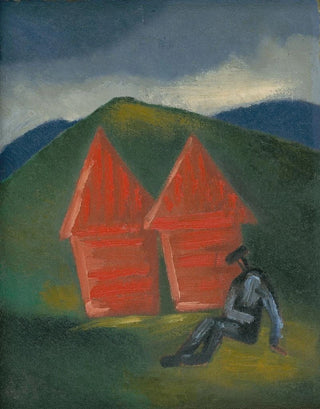Art print | Haystacks - Mikuláš Galanda


View from behind

Frame (optional)
Foin Barns - Mikuláš Galanda – Captivating Introduction
In the rich and diverse panorama of art history, certain works stand out for their ability to capture the essence of a particular era, place, or emotion. "Foin Barns - Mikuláš Galanda" is one such creation that, through its apparent simplicity, evokes an unexpected depth. This piece, depicting barns immersed in the gentle light of a rural landscape, invites the viewer to a serene contemplation. It not only highlights the beauty of nature but also the nostalgia for a world where harmony between humans and their environment was omnipresent. Galanda, through his subtle palette and delicate brushstrokes, manages to transport the viewer into an intimate universe where every detail matters.
Style and uniqueness of the work
Mikuláš Galanda's style is distinguished by a deeply personal and poetic approach. In "Foin Barns," the artist uses warm, earthy colors, creating a calming and comforting atmosphere. The shapes of the barns, though stylized, retain a certain authenticity reminiscent of traditional Slovakian constructions. This stylistic choice reflects a respect for rural heritage while incorporating a modern dimension. Light plays a predominant role in this piece, illuminating the barns in a way that seems almost magical, as if time has stood still. This ability to fuse the real and the imaginary is one of Galanda's trademarks, successfully turning each canvas into an invitation to escape and reflect.
The artist and his influence
Mikuláš Galanda, an emblematic figure of 20th-century Slovakian art, established himself through his originality and unique vision. Born into a modest background, he developed a deep attachment to nature and the landscapes of his homeland. His work reflects his personal and societal concerns, as well as an aesthetic quest that transcends borders. Galanda is part of an artistic tradition that values simplicity and authenticity, while incorporating various influences ranging from post-impressionism to modern movements. His work

Matte finish

View from behind

Frame (optional)
Foin Barns - Mikuláš Galanda – Captivating Introduction
In the rich and diverse panorama of art history, certain works stand out for their ability to capture the essence of a particular era, place, or emotion. "Foin Barns - Mikuláš Galanda" is one such creation that, through its apparent simplicity, evokes an unexpected depth. This piece, depicting barns immersed in the gentle light of a rural landscape, invites the viewer to a serene contemplation. It not only highlights the beauty of nature but also the nostalgia for a world where harmony between humans and their environment was omnipresent. Galanda, through his subtle palette and delicate brushstrokes, manages to transport the viewer into an intimate universe where every detail matters.
Style and uniqueness of the work
Mikuláš Galanda's style is distinguished by a deeply personal and poetic approach. In "Foin Barns," the artist uses warm, earthy colors, creating a calming and comforting atmosphere. The shapes of the barns, though stylized, retain a certain authenticity reminiscent of traditional Slovakian constructions. This stylistic choice reflects a respect for rural heritage while incorporating a modern dimension. Light plays a predominant role in this piece, illuminating the barns in a way that seems almost magical, as if time has stood still. This ability to fuse the real and the imaginary is one of Galanda's trademarks, successfully turning each canvas into an invitation to escape and reflect.
The artist and his influence
Mikuláš Galanda, an emblematic figure of 20th-century Slovakian art, established himself through his originality and unique vision. Born into a modest background, he developed a deep attachment to nature and the landscapes of his homeland. His work reflects his personal and societal concerns, as well as an aesthetic quest that transcends borders. Galanda is part of an artistic tradition that values simplicity and authenticity, while incorporating various influences ranging from post-impressionism to modern movements. His work






